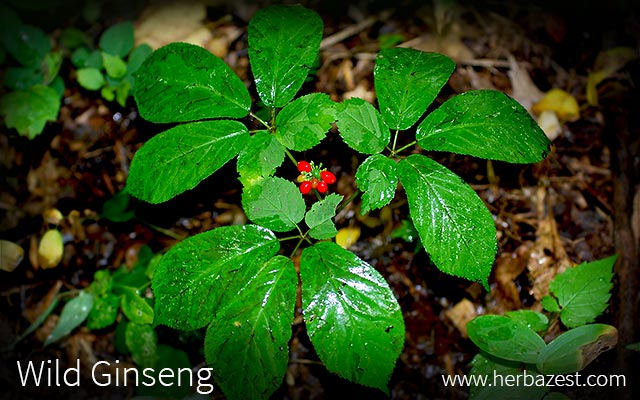Wild ginseng, also known as American ginseng (Panax quinquefolius), has become a widely-used medicinal herb over the past few hundred years, but the truly wild population is dwindling. Read on to learn more about the significance of wild ginseng in North America.
Characteristics of Wild Ginseng
Panax quinquefolius, commonly referred to as wild ginseng, belongs to the Araliaceae family and is a close relative of the Asian or Korean ginseng (Panax ginseng) but it is native to North America and cultivated across the continent.
As the plant matures, it develops three to five leaves, each with three to seven toothed, wedge-shaped leaflets. In the summer, the leaves are bright green followed by a yellow color in the fall. Wild ginseng flowers are greenish-white with 4 - 40 flowers on a stalk. Wild ginseng berries are bright red, and each contains two or three white seeds.
Types of Wild Ginseng
While there is only one species of the genus Panax native to North America, four types of wild ginseng can be distinguished according to the way it is grown:
Truly wild. This refers to wild ginseng that grows in natural forest habitats, including Quebec and Ontario in the north and Mississippi, Arkansas, and Georgia in the south.
Wild-simulated. The cultivation of wild-simulated ginseng is a man-made recreation of the growing conditions of truly wild ginseng to achieve a product that most closely resembles it.
Woods cultivated. This wild ginseng is man-grown in hardwood forests across Michigan, Pennsylvania, and the northeastern United States.
Field-grown. This is the wild ginseng grown in farms, mainly in Wisconsin, a state famous for cultivating ginseng in great quantity.
Wild Ginseng Benefits
Wild ginseng has been trusted by many for hundreds of years as a wonder herb that can help improve overall human health. Wild ginseng benefits are thought to help relieve conditions such as hypertension, diabetes, erectile dysfunction, and immunity issues.
A comprehensive review published by Evidence-Based Complementary and Alternative Medicine (2011) suggests that wild ginseng also may help to shorten the duration of colds and other acute respiratory infections in healthy adults when taken preventatively for 8 - 16 weeks.
How to Use Wild Ginseng
Wild ginseng leaves can be infused into tea, and the root can be ground into a powder. Capsules and tablets are also a very easy way to take wild ginseng with the added advantage of a safe, controlled dosage.
Wild Ginseng Supplements
Besides capsules and tablets, wild ginseng extracts and drinks have become a popular way to help increase alertness and enhance mental performance. A variety of brands offering wild ginseng energy drinks, alcoholic drinks, and infused teas can be easily found in herbal shops, supermarkets, and online retail stores.
Other Wild Ginseng Products
Due to its attributed anti-aging benefits, wild ginseng is sought by cosmetic companies to be used as an ingredient of moisturizers and creams, meant to alleviate the symptoms of aging and to help with skin conditions such as herpes.
Importance of Wild Ginseng
Over-cultivation of wild ginseng has truly left the herb in short supply. In fact, wild ginseng is now considered threatened in 16 states and endangered in 10 states. The American Herbal Products Association is working together with harvesters, consumers, nonprofit organizations, and regulatory agencies to protect wild ginseng in North America.
Wild ginseng is available in a variety of forms to help treat medical conditions and symptoms as well as to improve overall health. However, in order to reap its benefits for more years to come, further research and cultivation guidelines are needed to understand how to best preserve this endangered North American species.
Sources
- American Herbal Products Association, Good Stewardship Harvesting of Wild American Ginseng brochures
- Journal of Ginseng Research, American Ginseng: Research Developments, Opportunities, and Challenges, 2011
- Penn State University, Ginseng
- Kew Royal Botanic Gardens, Panax quinquefolius (American ginseng)
- University of Maryland Medical Center, American ginseng
- Evidence-based Complementary and Alternative Medicine, North American (Panax quinquefolius) and Asian Ginseng (Panax ginseng) Preparations for Prevention of the Common Cold in Healthy Adults: A Systematic Review, 2011




